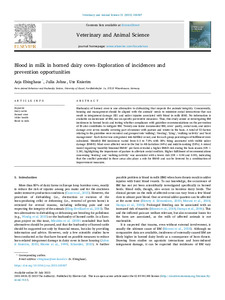| dc.date.accessioned | 2023-08-21T08:17:57Z | |
| dc.date.available | 2023-08-21T08:17:57Z | |
| dc.date.issued | 2023-07-20 | |
| dc.identifier | doi:10.17170/kobra-202308188645 | |
| dc.identifier.uri | http://hdl.handle.net/123456789/15007 | |
| dc.description.sponsorship | Gefördert durch den Publikationsfonds der Universität Kassel | ger |
| dc.language.iso | eng | |
| dc.rights | Attribution-NonCommercial-NoDerivatives 4.0 International | * |
| dc.rights.uri | http://creativecommons.org/licenses/by-nc-nd/4.0/ | * |
| dc.subject | dairy cattle | eng |
| dc.subject | horned cows | eng |
| dc.subject | udder health | eng |
| dc.subject | blood in milk | eng |
| dc.subject.ddc | 590 | |
| dc.subject.ddc | 630 | |
| dc.title | Blood in milk in horned dairy cows–Exploration of incidences and prevention opportunities | eng |
| dc.type | Aufsatz | |
| dcterms.abstract | Husbandry of horned cows is one alternative to disbudding that respects the animals´ integrity. Concurrently, housing and management should be aligned with the animals' needs to minimize social interactions that can result in integument damage (ID) and udder injuries associated with blood in milk (BM). No information is available on incidences of BM, nor on specific preventive measures. Thus, this study aimed at investigating BM incidences in horned herds and testing whether compliance with guideline recommendations on the prevention of ID also contributes to mitigate BM. Twenty-one farms documented BM, cows’ parity, social rank, and udder damage over seven months covering part of summer with pasture and winter in the barn. A total of 52 factors relating to the guideline were recorded and grouped into ‘milking‘, ‘feeding‘, ‘lying’, ‘walking/activity’ and ‘herd management’. Each factor was categorised into fulfilled or not, and for each group percentages of fulfilment were calculated. Monthly BM incidences varied from 0.3 to 7.8% with 38% being associated with visible udder damage (BMvD). Most cows affected were in the 2nd to 4th lactation (44%) and middle-ranking (58%). A mixed model regarding ‘monthly binomial BMvD’ per farm revealed a higher BMvD risk during the barn season (OR = 2.39), highlighting the importance of pasture to alleviate social conflicts. Higher fulfilment of recommendations concerning 'feeding' and 'walking/activity' was associated with a lower risk (OR = 0.94 and 0.95), indicating that the conflict potential in these areas also plays a role for BMvD and can be lowered by a combination of improvement measures. | eng |
| dcterms.accessRights | open access | |
| dcterms.creator | Ebinghaus, Asja | |
| dcterms.creator | Johns, Julia | |
| dcterms.creator | Knierim, Ute | |
| dc.relation.doi | doi:10.1016/j.vas.2023.100307 | |
| dc.relation.projectid | 2812NA104 | |
| dc.subject.swd | Milchkuh | ger |
| dc.subject.swd | Horn | ger |
| dc.subject.swd | Euter | ger |
| dc.subject.swd | Tiergesundheit | ger |
| dc.subject.swd | Milch | ger |
| dc.subject.swd | Blut | ger |
| dc.type.version | publishedVersion | |
| dcterms.source.identifier | eissn:2451-943X | |
| dcterms.source.journal | Veterinary and Animal Science | eng |
| dcterms.source.volume | Volume 21 | |
| kup.iskup | false | |
| dcterms.source.articlenumber | 100307 | |


